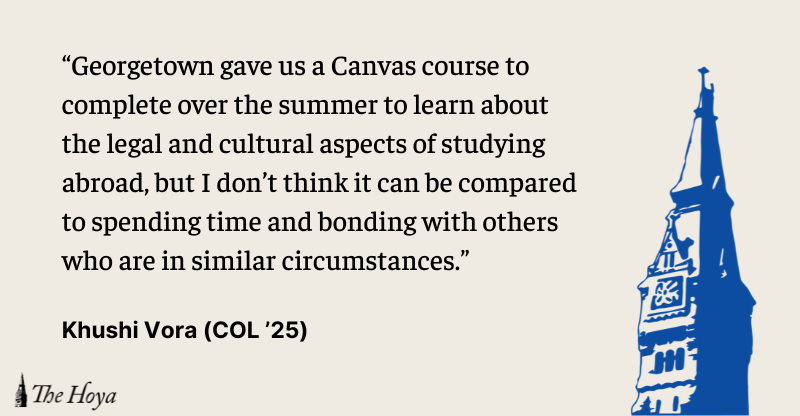Every week, I watch trees shed their leaves and feel the temperature drop a few degrees (Fahrenheit). In preparation for the move from India to Georgetown, I bought a few coats, a few scarves and a few pairs of leggings, while my shorts and crop tops sit at the bottom of my closet, crumpled and forgotten. I have a perpetual cold.
I’ve never experienced anything like this. When “Folklore” dropped last year, it was the collective consciousness of U.S. media that informed my feelings of the autumnal aesthetic, not my own memories. Growing up in sultry Mumbai, the coldest winds I felt came directly from the sea, still soaked with the humidity of the tropics. Sure, I remember to drop my u’s and soften my r’s, but I am still fundamentally unprepared for life abroad. I think the university could greatly help future students to feel prepared for by investing some time into a holistic orientation process.
I distinctly remember looking through the New Student Orientation schedule the night before it began, searching for the International New Student Orientation’s timings. When I stumbled upon it, it was only an hour or so with no location given. I spoke to a few other international students who were just as confused as I was, and this confusion turned into abject disappointment when that session turned out to be a Zoom meeting about complying with our visa requirements.
I’m always met with amazement when I mention I’m an international student from India. The responses range from “Wow, that’s SO far away!” to “Did you go to an English-speaking school?” Although I do like showing off my culture and upbringing, the constant explanation of habits and norms has worn down on me. Some of the novelty of university has faded away as well, and as the days get shorter and the nights — at Lau — get longer, I feel myself longing for the comfort of a home halfway across the world.
I’m extremely grateful for the diversity Georgetown already has among its domestic students and the resources it offers to promote cultural inclusion. The warm dinners and sermons at the Dharmālaya and the events hosted by the South Asian Society and Hindu Students Association do more than enough to make me feel incredibly connected and comfortable. By all accounts, I am well settled. But when I talk to friends at other universities, I can’t help but feel like I missed out on a crucial aspect of university life. The international student orientations my friends had helped them acquaint themselves with others just like them, fresh off 12-hour flights and a summer of visa appointments. It involved welcome dinners for students and families, bonding activities, international student guest speakers and more.
Georgetown gave us a Canvas course to complete over the summer to learn about the legal and cultural aspects of studying abroad, but I don’t think it can be compared to spending time and bonding with others who are in similar circumstances. I am lucky to have a few other students from my country, but many are the only people from their country studying here. The alienation of being a non-American when you’re in the heart of the United States is tough, and without social media and a few chance encounters, it would have been impossible for them to connect with others going through the same process.
Establishing an extensive in-person international student orientation program would provide us with a support system to deal with our relatively unique situations and to find others with similar backgrounds. Further, introducing the program across classes through a mentorship program could allow us to meet older students from the same country, which would be incredibly helpful for specific concerns about culture shock, homesickness and adaptation. The orientation would also allow for firsthand contact with American university culture and procedures. This type of hands-on learning would have a deeper impact than an online course. Once certain travel restrictions are lifted, the program would also be a source of comfort and security for parents dropping their children off, many of whom aren’t well acquainted with universities here and won’t be back until the following year.
As I bundle up and prepare for my first real Thanksgiving, I look forward to spending time with the rest of the international students who can’t go home for the break. Finding them has been a huge lifesaver for when I don’t understand what “low 60s” means or the intricacies of a football game, but I hope Georgetown can provide a more comprehensive resource for building these relationships through an international student orientation.
Khushi Vora is a first-year in the College.















Anaya Mehta • Nov 12, 2021 at 10:31 am
I love this opinion piece! So articulate and well written. I genuinely relate to every sentence and enjoyed reading it! So proud of Khushi